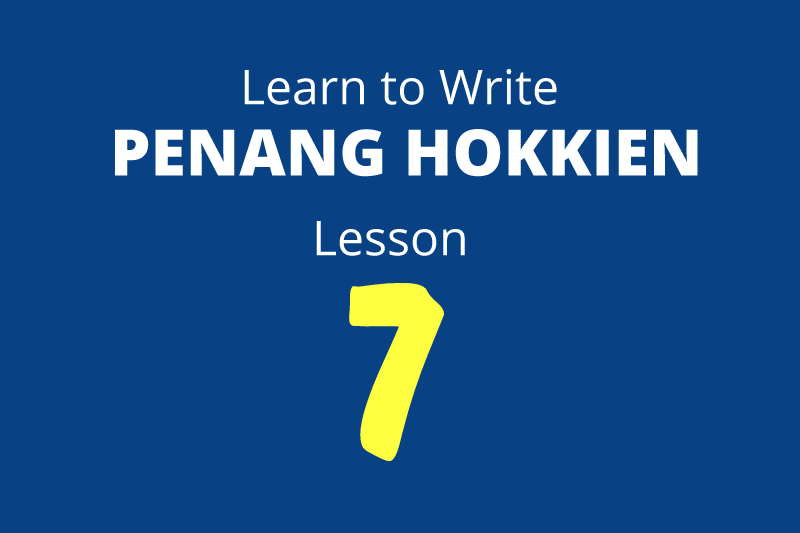
In our previous lesson, we learned I and you (wah4 and lu4) using Taiji Romanisation. In this lesson, we look at the third person singular personal pronoun: he, she and it.
In Taiji Romanisation, he is ie1
 , she is ee1
, she is ee1  and it is i1
and it is i1  . All three are pronounced /i/, or like the English letter "E".
. All three are pronounced /i/, or like the English letter "E".To understand why there is a masculine, feminine and neutral third person singular personal pronoun, we have to look at the role of writing system, not for the sake of writing, but rather, as a tool for effective and economical communication.
Penang Hokkien doesn't exist in isolation. All speakers of Penang Hokkien today speak it as their home mother tongue. However, it is a second language, or third, or even fourth language to them in writing. Any Penangite who is learning to write Penang Hokkien is likely to know how to write English or Mandarin or Malay. Of these three languages, English and Mandarin do separate the third person singular personal pronoun by gender. By likewise splitting the third person singular personal pronoun, when you translate between English or Mandarin with Penang Hokkien, you don't suffer a loss of clarity.
With most writing systems, people only get to learn it. There is no opportunity for enhancement. Penang Hokkien is the rare opportunity where I have a hand in designing the writing. My decision is to make the writing system more precise than the spoken form. The written form of Penang Hokkien should not be a direct mimic of the spoken form. They should be regarded as two different ways of communication. Spoken communication is usually done in the present, between two or more people, face to face, or via the telephone or Skype. In comparison, written communication has a time lapse between when the writing was done and when the writing is read. It is rarely ever immediate. For example, we have access to read books written by authors that are now long gone. Nonetheless, they continue to communicate with us through their written word. Even this Facebook post, will continue to communicate with readers visiting the Learn Penang Hokkien FB Page hours, days, weeks and even months after it was written.
Effective written communication depends on clarity and economy. Unlike a conversation, if a reader does not understand something, he has no opportunity to seek elaboration from the writer. After writing this post, I could be doing something else. If someone asks a question, I might not see it again until maybe the next day, and when I do reply, the person who asked might not be around also. The beauty of the written word is that it encapsulates the message and retain it until such time that someone reads it, then the communication is released.
And for that reason, the third person singular personal pronoun is split by gender; he is ie1, she is ee1, it is i1.
The very good news about these three is that they never undergo tone change. They are always the same, whether you use them as a subject or an object. Of course, that also mean that they have no emphatic form. See these examples:
I call him. He calls me.
Wah1 kio33 ie1. Ie1 kio33 wah4.

She calls him. He calls her.
Ee1 kio33 ie1. Ie1 kio33 ee1.

She calls it. It bites her.
Ee1 kio33 i1. I1 ka33 ee1.

You can translate between English, Mandarin and Penang Hokkien without having to work around.
Previous Lesson | Main Page | Next Lesson
Learn Penang Hokkien with Memrise
Now you can use the most user-friendly tool on the web to learn Penang Hokkien. It helps you to listen, understand and memorise. Go to Memrise, and learn Penang Hokkien at your own pace.
Return to Penang Hokkien Resources
Latest from Discover with Timothy: Gurney Bay - what to see and do there
About this website

Hello and thanks for reading this page. My name is Timothy and my hobby is in describing places so that I can share the information with the general public. My website has become the go to site for a lot of people including students, teachers, journalists, etc. whenever they seek information on places, particularly those in Malaysia and Singapore. I have been doing this since 5 January 2003, for over twenty years already. You can read about me at Discover Timothy. By now I have compiled information on thousands of places, mostly in Peninsular Malaysia and Singapore, and I continue to add more almost every day. My goal is to describe every street in every town in Malaysia and Singapore.
Robbie's Roadmap
- Episode 1: Robbie's Journey to Financial Freedom
- Episode 2: Lost in America
- Episode 3: The Value of Money
- Episode 4: The Mentor
- Episode 5: The Thing that Makes Money
- Episode 6: The walk with a Billionaire
- Episode 7: The Financial Freedom Awakening
- Episode 8: Meet Mr Washington
- Episode 9: The Pizzeria Incident
Copyright © 2003-2024 Timothy Tye. All Rights Reserved.


 Go Back
Go Back